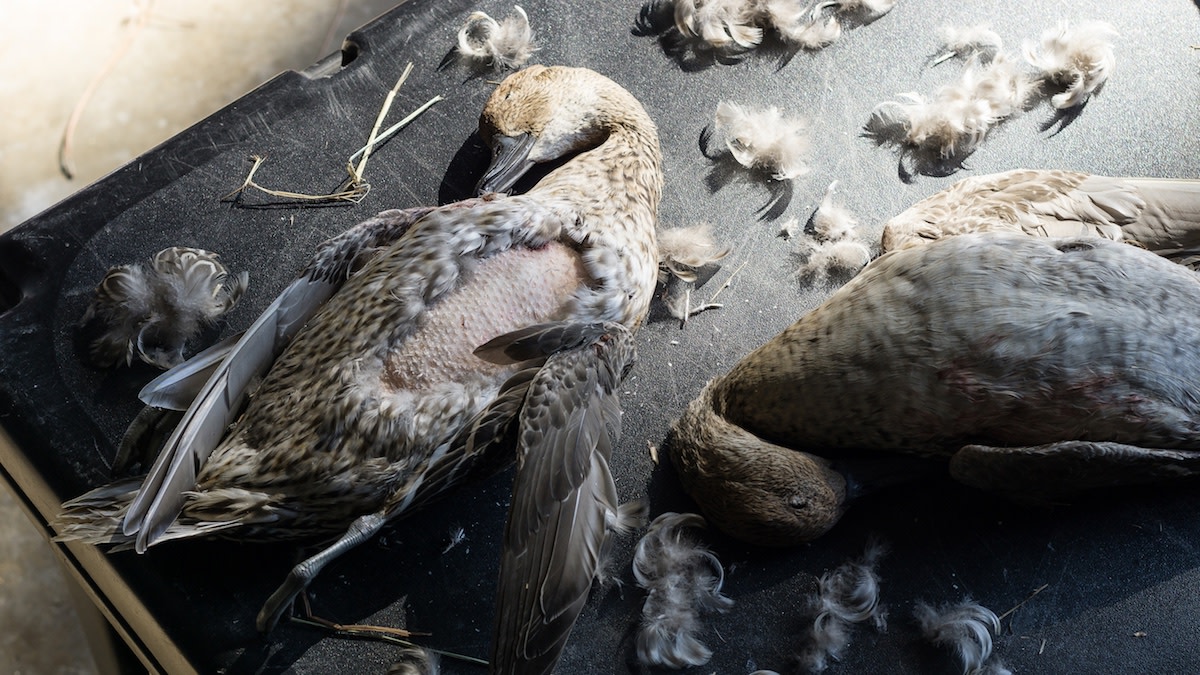
After a successful duck hunt, the idea of plucking each bird one by one might sound like a chore—especially when you’re cold and tired. But if you’ve ever had a perfectly seared duck breast with crispy skin, then you know it’s worth the effort. After years of plucking ducks, I’ve discovered a few things to help make the job a little easier.
Dry, Wet, or Wax?
I’ve tried various methods of plucking, but I’ve found dry-plucking ducks to be my favorite. This is simply plucking a dry bird by hand and is what I will discuss more in-depth below. It’s not the fastest way to pluck, but it is very effective! I’ve never had success dipping them in scalding water (aka wet-plucking). Waterfowl feathers are built to protect and insulate their skin from the cold, and they have an oil gland that secretes wax to make them somewhat waterproof. This explains why this method is ineffective because water can’t penetrate the feathers to loosen from the skin.
Another method for plucking is waxing—dipping the bird in hot paraffin wax and peeling off the wax with feathers attached once it's cool. This typically works very well. However, it does create quite a mess, and I’ve found it's only practical if you have a lot of birds to pluck (I’m generally not that lucky).
Choose the Right Birds
Whatever method you decide to choose, make sure to pick out the right birds to pluck! Not every duck or goose is a good candidate. The best species to pluck are dabbling ducks, like mallards, wood ducks, or pintails, but I also like plucking smaller geese like specklebellies and snows. I don’t mess with plucking Canada geese because I rarely sear the breast meat (they can be tough), and they’re generally harder to pluck.
I also skim my hand under the feathers to check for wounds. One or two BB holes are completely normal, and if you’re really lucky, the breast will be free of damage. I don’t waste my time plucking a duck that’s been shot up pretty badly and prefer to skin it.
Prepare for Plucking
Before diving into the plucking job, I find that chilling the birds whole for 24 hours helps to tighten the skin and dry out the feathers. I like to do this in a refrigerator, placed on top of cardboard. Warm, loose skin is more prone to tearing when plucking. And yes, I leave the head and guts intact. This is perfectly safe so long as it hasn’t been shot up too badly or a dog hasn’t crushed the bones and punctured the intestines.
When preparing to pluck, think about how you want to cook it. If you’ve got a perfect specimen with little damage, you might want to roast or smoke the whole bird, which means you’ll need to pluck the whole bird. But sometimes that isn’t necessary, maybe the dog broke a thigh and you’d rather sear the breast meat and slow-cook the legs separately, in that case, you only need to pluck the breast. I almost never pluck the wings because there just isn’t enough meat on a duck to make it worth it.
When you’re ready to pluck, have a large trash can or bag for the feathers, some tunes playing in the background, and get comfortable. Plucking requires a little patience. I’m pretty meticulous when it comes to plucking and like to take my time.
How to Dry-Pluck a Duck
If the bird is wet, make sure to dry it. Moisture will make the feathers stick to your hands so it’s best to make sure it’s pretty dry. I start with the easy down feathers on the chest, pinching a small amount in between my thumbs and pulling in quick, upward motions. As you pluck, make sure you're pulling the skin taut with your other hand. The trickiest part is getting the larger contour feathers on the neck and the sides below the wing. Work one feather at a time and pull it out in a swift motion.
Don’t get greedy and grab a large handful of feathers, thinking you’ll make the job go quicker, you can easily tear the skin or leave the quill behind. The quill generally has to be removed with tweezers, and it’s very tedious to do. Also keep in mind that molting ducks will have new feather growth called pin feathers. These are more difficult to pull, and you should take your time.
Sometimes tearing is inevitable, or there may be holes already from bb’s. Hold your finger over the hole, pull the skin tight, and work around it carefully. Finally, use a blowtorch to singe small down feathers you might have missed or in the difficult areas around wings and foot joints.
When you’re done plucking, process and remove the guts as you normally would. Rinse the skin well with water to clean any blood or char from singing feathers. At this point, you can freeze them for later use or start making dinner plans. You definitely want to make the most of the hard work you’ve put into it with a special meal. To roast it whole, try Steve’s roasted duck with apple chutney. If you’re just searing the breast meat, pair it with fries and blue cheese butter!
While plucking ducks can be tedious, it can also be a fun job when you’re doing it with your hunting buddies or family. And I don’t know a single person who has ever eaten a seared duck breast and wished they didn’t pluck it!





